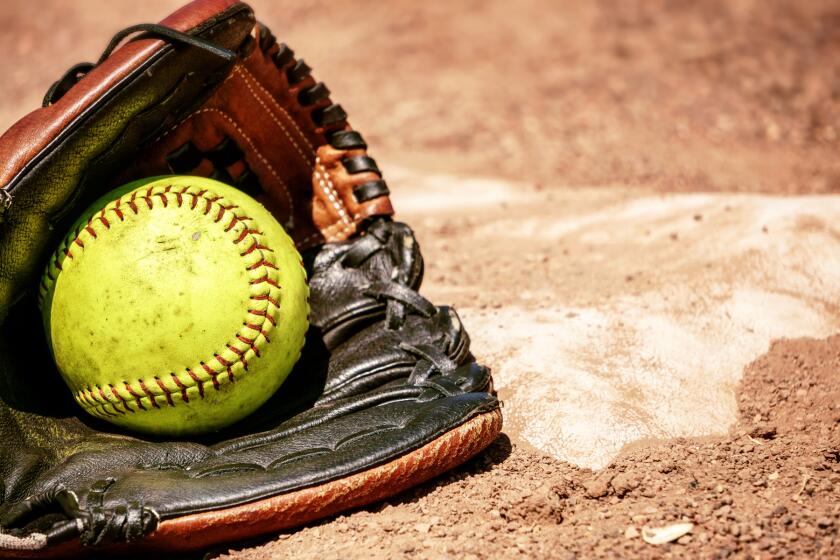It’s a Small World
- Share via
“Where’s Larry Bird at?
“Where’s he at?”
The kid was so cute.
Bird stood in a dark Staples Center corridor. He was in town on Indiana Pacers’ business, scouting the Pacific 10 Conference tournament, not granting press interviews and only begrudgingly scratching out his signature.
Gee whiz, though, this scene was playing out like Mean Joe Greene and that pipsqueak in the famous soft drink commercial.
The tyke approached Bird for an autograph.
“Got it,” the kid beamed to his friends.
In fact, next to beating UCLA earlier that evening with his jackrabbit hops and dribble penetration, getting Bird to put pen to parchment might have been the highlight of the young man’s day.
The autograph seeker, jeered by opposing crowds this year with taunts of “Gary Coleman! Gary Coleman!” was Washington sophomore guard Nate Robinson, who looks young enough to be your paperboy and stands 5 feet 9, maybe, in his cowboy boots.
Being vertically challenged has not stopped the box-shaped Robinson -- Nate the Crate? -- from becoming a driving force in college basketball.
In case you haven’t noticed, the Lilliputians are taking over.
Kids not tall enough to get on Disneyland rides three years ago are now the difference makers in a sport where, oxymoronically, the players keep getting taller even as the peach basket remains tacked at 10 feet.
If you need a movie theme for this year’s NCAA tournament, which begins Thursday in arenas across America, it might be “Get Shorty.”
Thirty writers who regularly cover Pac-10 basketball were recently asked in a newspaper survey which conference player they would pay to watch.
Nate Robinson won in a landslide.
At the Pac-10 Tournament, Robinson ran Keystone Kop circles around opposing guards in leading Washington to the finals run it needed to lock up an NCAA bid -- the Huskies open tournament play Friday, against Alabama Birmingham, at Columbus, Ohio.
“I just try to be like a little fly,” Robinson said after his first-round matchup with 6-6 UCLA guard Cedric Bozeman. “Guys don’t like little things that just keep bothering them. I just try to get under his skin.”
After Robinson had scored 20 points against Arizona in the tournament semis, 6-11 Wildcat center Channing Frye muttered, “That guy is kind of feisty.”
Pete Newell, the legendary basketball coach and mind who runs the annual Big Man Camp in Hawaii, came away from the Pac-10 tourney infatuated with the tiniest guy on the court.
“I was amazed,” Newell said of Robinson.
Robinson leads a long list of 6-foot-and-under stars leading their teams into this NCAA tournament:
* Jameer Nelson, Saint Joseph’s (the probable national player of the year).
* Raymond Felton, North Carolina (He of “Everybody Loves Raymond” T-shirt fame).
* Tim Smith, East Tennessee State (Better watch out, Cincinnati).
* John Lucas III, Oklahoma State.
* Andre Barrett, Seton Hall (A little guy who made first team in the Big East).
* Dee Brown, Illinois (Nickname is “the Human Fastbreak”).
* Will Bynum, Georgia Tech.
* Mo Finley, Alabama Birmingham (He faces off against Robinson in first-round NCAA action).
* Chris Paul, Wake Forest.
Last year, three of the 10 finalists for the John R. Wooden Award -- T.J. Ford of Texas, Brandin Knight of Pittsburgh, and Jason Gardner of Arizona -- were short guys.
Ford won the Wooden Award, and Nelson of Saint Joseph’s is favored to win it this year.
St. Peter’s College did not make this year’s NCAA field, but its 5-8 sophomore guard, Keydren Clark, became the first 6-foot-and-under player to lead the nation in scoring since Kevin Houston of Army in 1987.
Short guys have always had a place in college basketball; Calvin Murphy of Niagara and Monte Towe of North Carolina State come to mind.
One of the most memorable moments in NCAA tournament history occurred in 1995 when UCLA half-pint Tyus Edney went baseline to baseline to beat Missouri on a last-second shot.
Newell’s University of San Francisco squad, which won the National Invitation Tournament in 1949, was led by 5-9 guard Rene Herrerias.
However, the emergence of the small guy in the modern game is nothing short of a renaissance.
“The small guy has always been over-judged, I thought, on his weaknesses,” Newell said. “But what he brings to a team totally is far more positive than the negatives he brings.”
Newell says it is not coincidence that small players are having a bigger effect on today’s game.
The best big men are fleeing for the NBA in droves. Some, like LeBron James, are going straight from high school to the professionals.
“The little guys don’t go out early,” Newell said. “Right or wrong, the NBA doesn’t put that much attention to them. They feel it’s a lot easier to get small guys than big guys. And it’s true.”
Tony Bennett, a Washington State assistant coach and a former short-stuff star, says early defections have changed the game.
“The college game now is the ability to create off the dribble, and that really puts a premium on guys who can dribble, pass and shoot,” he said. “The game has gone to the smaller guy who can wheel and deal and make plays.”
Another major philosophy shift has made it easier for small players to make noise: zone defense.
For years, professional and college basketball were dominated by man-to-man principles.
Until recently, in fact, zone defense was not allowed in the NBA.
In short, short guys couldn’t match up and coaches, looking to keep their jobs, couldn’t afford to have small players in games at critical points because taller players could post them up for easy baskets.
“You see the emergence of the small player more and more the last few years,” Newell said. “That’s because of the zone.”
In this new era, Washington Coach Lorenzo Romar has found ways to get the most out of Robinson. He can use his point guard to pester taller point guards in a full-court press and then protect him in zone defense in half-court sets.
“You can’t totally take advantage of them defensively because you’ve got help inside in college,” Romar says of smaller guys.
And the upside?
“They can pressure the ball,” he said. “They can break down defenses. If you got guys who can break the defense down, you create a lot of problems for people.”
Newell, who has spent the later part of his life developing the skills of big players, said the NBA’s longtime rule forbidding zone defense turned the pro game into half-court slugfests.
“The fastbreak had just disappeared from NBA basketball,” he said.
Newell applauds the league’s decision to relax zone rules and says it has opened avenues for overachievers.
“The NBA is always looking for a way to make the game more exciting,” Newell said. “.... No one makes it more exciting than a small man.”
Twenty-five years ago, the emergence of Magic Johnson, a 6-9 point guard, threatened to put small players out of business.
But that trend has run its course, and small is back in vogue.
Last year, Syracuse became one of the few schools to win a national title playing zone defense.
Newell says this will only encourage more teams to play zone and counts it as another victory for the small players.
Bennett says more college coaches are realizing lack of size can actually be an advantage.
“You’d rather take a guy who’s a couple of inches smaller who can flat-out play than a guy who looks good, or is a little stiff, but has the physical dimensions,” Bennett said. “You cannot account for what’s inside the heart and just the pure ability to get stuff done.”
Bennett knows something about this short subject.
In 1992, while playing for his father, Dick, at the University of Wisconsin Green Bay, Tony won the Frances Pomeroy Naismith Award, given annually to the nation’s most outstanding 6-foot-or-under senior.
After college, Bennett played three years with the NBA’s Charlotte Hornets. A teammate there was Tyrone “Muggsy” Bogues, who stood 5-3.
Bennett remembers Bogues put out a video titled “Don’t Tell Me No.”
Bennett said he sees the same attitude in Robinson.
“That’s just the mind-set you have if you’re a smaller guard,” Bennett said. “It’s, ‘I don’t care what anybody says about me, I will prove to you.’ That’s what you see in the Nate Robinsons.”
Robinson may be short, but he’s also, as Romar says, “one tough hombre.”
Jacque Robinson, Nate’s dad, was a star running back at Washington and earned MVP honors in the 1982 Rose Bowl.
Nate played cornerback on Washington’s football team as a freshman before deciding to concentrate on basketball only this season.
Robinson’s height was probably genetically determined by his 5-11 father and 5-foot mother, Renee.
“I always wanted to be tall, like Michael Jordan,” Nate said, “but I knew it just wasn’t going to happen.”
Nate was blessed in other ways -- he is quick as a cat and has a 40-inch vertical leap.
Against UCLA in the Pac-10 tournament, Robinson made a spectacular block against 6-10 Bruin forward T.J. Cummings.
In a game against Arizona this year, teammates swore Robinson’s eyes were above the rim on an alley-oop slam dunk.
Robinson has never let size get him down -- he simply downsized his role models: Bogues, Allen Iverson, Earl Boykins.
He says he’ll never forget, as a kid, seeing highlights of the 5-7 Spud Webb winning the NBA’s dunk contest.
“It’s, like, I know I can dunk if he can dunk,” Robinson said.
He also says small guys don’t have the luxury of taking talent for granted.
“We just work 10 times harder than everyone else because we’re smaller,” he said.
How hard?
“I play basketball every day,” he said. “Every single day. Friday nights, I don’t go out to no parties. I play basketball. I work on everything I need to work on because I know other guys are bigger than me.
“It’s like David and Goliath. I’m a little dude and I like to fight.”
*
(BEGIN TEXT OF INFOBOX)
No Shortage Here
Prominent 6-foot-and-under players in the NCAA tournament. Bold type indicates player is team leader in statistical category:
*--* Player School Ht. Wt. Cl. Pts. Ast. ANDRE BARRETT Seton Hall 5-10 170 Sr. 17.6 5.9 WILL BYNUM Georgia Tech 5-11 185 Jr. 9.6 2.7 MARTELL BAILEY Illinois Chicago 5-10 170 Sr. 7.7 *7.9 DEE BROWN Illinois 6-0 175 So. 13.0 4.5 MALCOLM CAMPBELL Alabama State 5-10 155 Sr. 13.0 3.3 RAYMOND FELTON North Carolina 6-0 185 So. 11.5 *7.2 MORRIS FINLEY Alabama Birmingham 5-11 165 Sr. 13.5 1.7 JOHN LUCAS III Oklahoma State 5-11 155 Jr. 15.4 4.6 JAMEER NELSON Saint Joseph’s 5-11 190 Sr. 20.0 5.4 CHRIS PAUL Wake Forest 5-11 168 Fr. 14.2 5.8 NATE ROBINSON Washington 5-9 170 So. 12.7 2.7 TIM SMITH East Tennessee State 5-9 155 So. 17.4 4.5 T.J. SORRENTINE Vermont 5-11 185 Jr. 14.6 4.6
*--*
* Bailey and Felton rank second and fourth nationally in assists.
More to Read
Go beyond the scoreboard
Get the latest on L.A.'s teams in the daily Sports Report newsletter.
You may occasionally receive promotional content from the Los Angeles Times.











